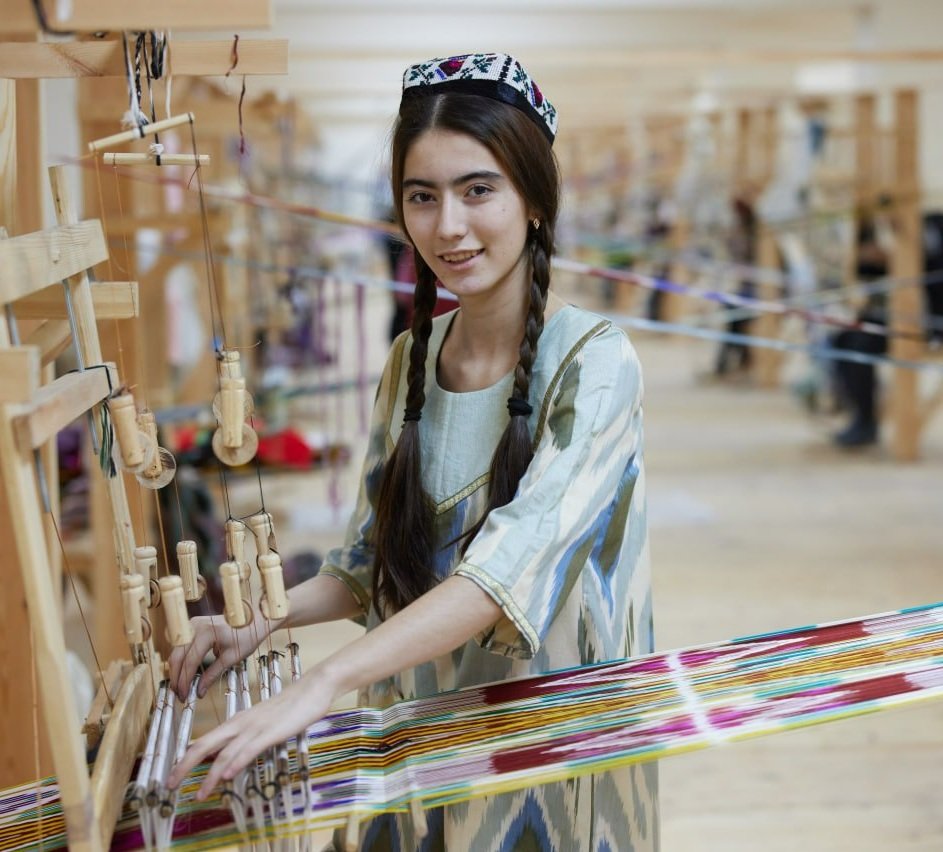Margilan
City of Poetry and Silk
Tucked into the fertile Fergana Valley of eastern Uzbekistan is Margilan, a Silk Road city known for its handicrafts. Margilan is truly ancient – the earliest written sources about it date to the 10th century, though its origins go much further back. Today, Margilan is in the throes of growth and change. Modern monuments and skyscrapers have been built alongside its preserved historical monuments, which include the Pir Siddiq complex, the Khanaqah mosque, and the mausoleum of Hasti Maoz.
Located along the Silk Road, Margilan was undoubtedly an influential and important city, traditionally home to many artisans, particularly fabric and silk makers whose wares were traded up and down the Silk Road. Even today, the city remains particularly well-known as being a centre of silk weaving.
City of Sages and Poets
Margilan was mentioned by 19th century Uzbek historian Iskhoqhon Ibrat, in his book, History of Fergana, as well as in The Memoirs of Babur (Baburnama). And it was in the Fergana Valley that an urbanised, Indo-European speaking culture (the Dayuan) encountered the Chinese civilisation for the first time. This exchange eventually led to the opening of the Silk Road from the 1st century BC on.
According to Russian/Soviet historian Vasily Barthold, Margilan was the capital of the Fergana Valley in the Karakhanid period (around the 9th to 13th centuries). The city is also sometimes referred to as the ‘Sanduk ul-Arifin’ (‘Box of the Arifs’– in Arabic, ‘arif’ means smart, knowledgeable and wise), because many scientists and sages, particularly, Burkhaniddin al-Margilani, Uwais, Khazin Margilani, grew up here.
Margilan was also the hometown of Sufi poet Jahon Otin Uvaysiy[1] (1780–1845), who was an otine (female scholar of Islam). Uvaysiy wrote some 15,000 lines of verse (hemistiches)
City of Silks and Fabrics
Perhaps Margilan’s most-well known contribution to Uzbek culture is its production of traditional silks and fabrics. The city is home to the largest silk producers in Uzbekistan: Yodgorlik Shoyi Korkhonasi and Turon Shoyisi, as well as some 600 other small, private workshops and fabric factories.
@katerine6369@gmail.com @jamsaf@gmail.com I suggested that we try to find an image, like an old painting or something in the public domain, of this poet to include.
In recent years, the demand for Margilan ikat fabrics (atlas, adras, shoiy, beqasam) has increased dramatically, with orders coming from across Uzbekistan and around the world. The city owes its reputation for high-quality silk to the fact that all aspects of fabric production happen in one place, starting with the cultivation of the silk worms, all the way down to preparing natural dyes with traditional methods.
Most tourists visiting the Fergana Valley want to buy Margilan atlas, and the presence of so many workshops means that there are ample opportunities to see how it is created and what types are available, as well as to meet the artisans and learn about their stories and family histories.
Several master artisan families also run guesthouses, including Nabijon Toshtemirov and Rasuljon Mirzaakhmedov (Ikat House, 133 Ipak Yuli St, ikatuzcenter@gmail.com). A guesthouse stay generally includes a visit to the workshop and a chance to meet and talk with the master artisans, as well as home comforts like a traditional Uzbek meal and cosy accommodation
What are abr-ikat fabrics?
The local name for ikat is abr (‘cloud’ in Persian), as the traditional patterns are said to resemble clouds floating in the sky or reflected on water. The abr-ikat fabrics of the Fergana Valley generally come in four varieties: adras, atlas, shoiy-bahmal and beqasam. These fabrics are made using ikat – a technique of bundle-dyeing thread before it is woven, resulting in unusual patterns, such as the classic Uzbek floral and geometric patterns. Traditionally woven with a glossy silk warp, adras is a mix of silk and cotton, while atlas fabric is made of pure silk. Shoiy is the finest (thus most expensive) type of local silk velvet fabric. Beqasam is a silk-cotton striped fabric used for chapon robes and other men’s attire, but now seen only rarely. Each of these fabrics also has subtypes. For example Khon-atlas features golden threads and more vivid red-yellow patterns, while A’lo-bahmal is a rare bahmal velvet.
Colour plays a critical role in the symbolism of abr-ikat fabrics. Brilliantly hued, these textiles generally incorporate bright pinks, warm yellows, dark blues, rich reds and so on. The dyes traditionally are created from various natural plants or the peels of some fruits. The beauty and staggering colours of adr-ikat fabrics, especially in the silhouettes of Uzbekistan’s national costumes, are a favourite souvenir for many visitors.





